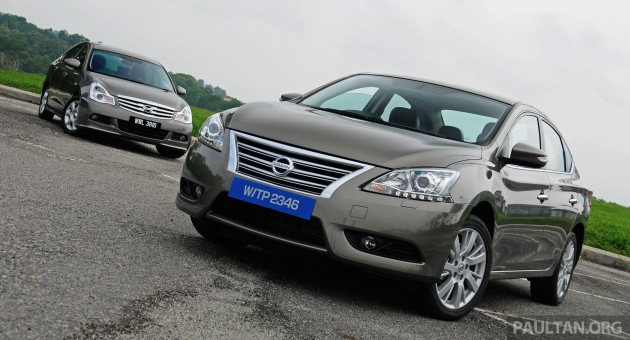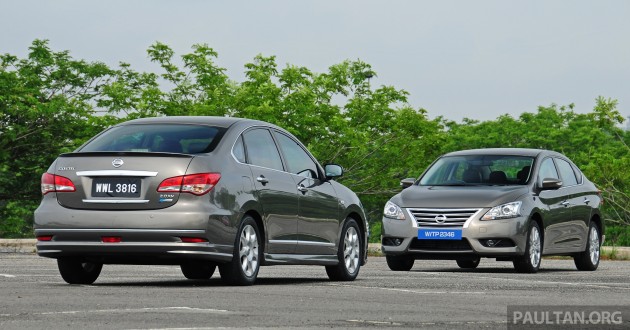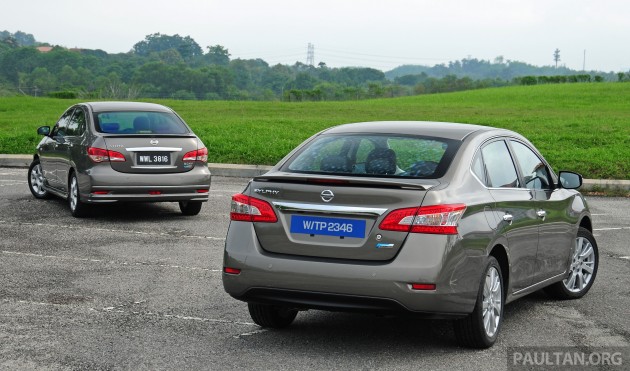
The new 2014 Nissan Sylphy may not have a ground-breaking design, but put it side-by-side with the car it replaces like we did and you may start thinking otherwise. The original G11 Sylphy has certainly aged since its 2008 debut, yet there's no denying the paradigm shift the new B17 Sylphy represents.
Not when the differences are as stark as this. From the outside, you wouldn't have guessed that the two are even related at all. It's not quite a sexy car, the new one, but its dynamic contours and sharp lines sure project a fair bit more road presence than its bold, yet rather featureless predecessor.

Round the back, tauter curves make the B17 appear more grounded and less bulbous than the G11. It helps too, of course, that the wheels have been upsized from the 16-inchers of old to the new one's multi-spoke 17-inch design. Fills up the (now more pronounced) wheelarches better.
Also improved is the choice of tyres: up from the blunt 195/60 R16 Bridgestone B250 items on the old car to more upmarket 205/50 R17 Continental ContiPremiumContact 2E rubbers on the new. Another favourable move is the inclusion of rear disc brakes, in place of standard rear drum brakes on the G11.
Dimensions have been altered slightly. Much has been said of the original Sylphy's narrow footprint, and so the new one is a full 60 mm wider. At 4,615 mm-long, it's 50 mm shorter than before too – all of which have come off the overhangs, as the class-leading 2,700 mm wheelbase remains.
The Sylphy's cabin has gone through an extensive makeover too. From the dashboard to the seats, and everything else in between, it's all new. Silver trim pieces now replace the wood inserts in the old car, and there's now a proper push start button instead of a crude make-shift twist-to-start mechanism.
Nissan has completely revamped the rear seats, which now take on a more conventional form instead of the unorthodox 'clamshell' approach of the old car. This change is certain to split opinions, though passengers in the new car benefit from a 30 mm-wider shoulder room and the inclusion of rear air-con vents.
Changes under the hood are less dramatic. Out goes the MR20DE 2.0 litre C-VTC engine of the G11, replaced by a more advanced MRA8DE 1.8 litre Twin C-VTC motor in the B17. Though identical on paper, the Xtronic CVT transmission in the new car is of a newer design.

Predictably, engine outputs are down from 133 PS at 5,200 rpm and 191 Nm at 4,400 rpm to 131 PS at 6,000 rpm and 174 Nm at 3,600 rpm. As such, the horsepower drop is near negligible, while the maximum torque, though significantly less, is now available much lower in the rev range.
Last, but certainly not least is the very welcome upgrade from just two to six airbags, and the standard inclusion of electronic stability control across the range. The Sylphy sure has come a long way since the original. Compare the new and the old in our exclusive like-for-like gallery below, and if you haven't, do take a look at our comprehensive review and walk-around video of the new Nissan Sylphy.
2014 B17 Nissan Sylphy 1.8 VL
2012-2013 G11 Nissan Sylphy 2.0 XV



No comments:
Post a Comment